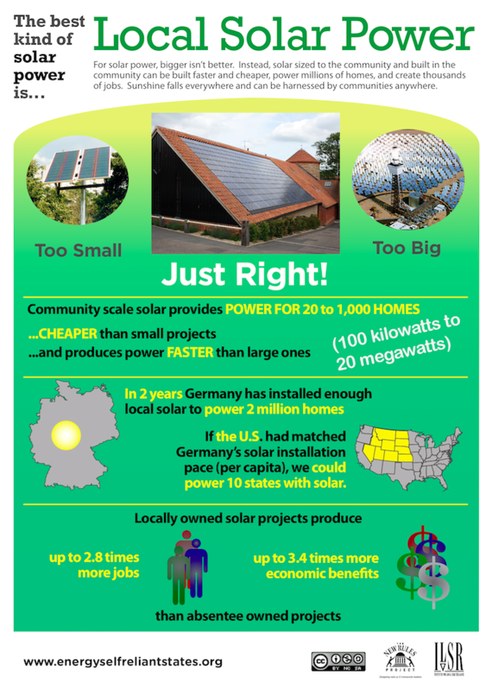
As Americans, we’re conditioned to think big. Big houses, big cars, big screens. Big, centralized power plants that blast energy to our big cities and big suburbs. But there’s a compelling argument to be made for breaking with that paradigm, and starting to think smaller. Of course, that applies to all of the above, but let’s focus on power generation.
Most of us get our power from ginormous coal, gas, nuclear, or hydro plants that create a massive amount of power and transmit it far across the grid. So, as we shift to renewable power, many expected we’d follow that mold, with huge solar arrays and sprawling wind farms. While those are great, there’s reason to believe that seeking to stimulate the growth of a bevy of smaller, local solar projects would be faster, more cost effective, and create more jobs. This infographic/advertisement for local solar explains

You might recall how Germany has set a fantastic precedent in solar (even though the nation doesn’t even get all that much sun), by deploying feed-in tariffs and other policy instruments that encourage local, smaller-scale solar power development. As a result, they’ve added enough solar power over the last two years to power 2 million homes with clean energy.
There are other reasons to seek out local, or distributed power sources like rooftop solar, too — for instance, most Americans’ power relies on a centralized grid right now. If the plant goes down or a crucial transmission line is severed (and this happens more easily than you’d think), then it’s lights out, sometimes for an entire region. Distributed power generators circumvent that problem — if there’s a problem with one, it doesn’t domino into surrounding regions.
And then there’s the jobs and economic factors — larger projects require less manpower and more machine power than a bunch of smaller ones that equal its generating capacity. In other words, policies that encourage widespread adoption of distributed solar — primarily the mighty feed-in tariff, or FIT — are a no-brainer.
Source: treehugger

 Follow
Follow